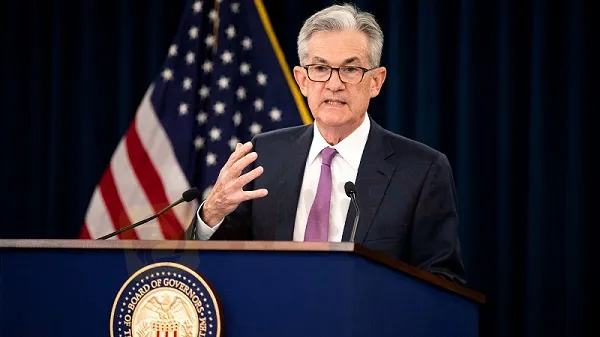简体中文
繁體中文
English
Pусский
日本語
ภาษาไทย
Tiếng Việt
Bahasa Indonesia
Español
हिन्दी
Filippiiniläinen
Français
Deutsch
Português
Türkçe
한국어
العربية
Fed Sees Three Rate Hikes in 2022 as Inflation Battle Begins
Abstract:That would kick off a hiking cycle that would see the Fed's policy rate climb to 1.6% in 2023 and 2.1% in 2024 - nearing but never exceeding levels it would consider restrictive of economic activity.

The Federal Reserve, signaling its inflation target has been met, said on Wednesday it would end its pandemic-era bond purchases in March and pave the way for three quarter-percentage-point interest rate increases by the end of 2022 as it exits from policies enacted at the start of the health crisis.
In new economic projections released following the end of a two-day policy meeting, officials forecast that inflation would run at 2.6% next year, compared to the 2.2% projected as of September, and the unemployment rate would fall to 3.5% - near if not exceeding full employment.
As a result, officials at the median projected the Fed's benchmark overnight interest rate would need to rise from its current near-zero level to 0.90% by the end of 2022. That would kick off a hiking cycle that would see the Fed's policy rate climb to 1.6% in 2023 and 2.1% in 2024 - nearing but never exceeding levels it would consider restrictive of economic activity.
It is, in outline, the “soft landing” that Fed officials hope will transpire, with inflation gradually easing in coming years while unemployment remains low in a growing economy.
The timing of the first hike this year, the central bank said, would now hinge solely on the path of a job market that is expected to continue improving in coming months.
Dropped from the policy statement was any reference to inflation as “transitory,” with the Fed instead acknowledging that price increases had exceeded its 2% target “for some time.”
Annual inflation has been running at more than double the Fed's target in recent months.
To open the door to rate hikes, the Fed announced it was doubling the pace of its bond-buying “taper,” putting it on track to end the program, initially begun at $120 billion per month, by March.
U.S. stocks added to modest gains after the release of the statement and projections while yields on Treasury securities rose. The dollar strengthened against a basket of major trading partners' currencies.
Traders in interest rate futures were pricing a first hike in May, and two more by the end of 2022.
Though the Fed made any rate hikes contingent on some further improvement in the job market, the new policy projections left little doubt that borrowing costs will rise next year, absent a major economic shock. All 18 policymakers indicated at least a single rate increase would be appropriate before the end of 2022.
All told, the new projections and policy statement began to pin down the central bank's plan to “normalize” monetary policy following nearly two years of extraordinary efforts to nurse the economy through the fallout of the pandemic.
That is still underway, the Fed acknowledged, with the new Omicron coronavirus variant adding to uncertainty about the course of the economy.
But the Fed, at this point, said economic growth is still expected to be 4.0% next year, an increase over the 3.8% projected in September and more than double the economy's underlying trend.
Fed Chair Jerome Powell is scheduled to hold a news conference at 2:30 p.m. EST (1930 GMT) to elaborate on the new policy statement and answer questions about the central bank's economic outlook.
For more Forex news, please download WikiFX- the Global Forex Regulatory Inquiry APP.
Disclaimer:
The views in this article only represent the author's personal views, and do not constitute investment advice on this platform. This platform does not guarantee the accuracy, completeness and timeliness of the information in the article, and will not be liable for any loss caused by the use of or reliance on the information in the article.
Read more

FED meeting minutes strongly hint at a rate cut in September; US dollar index falls to new low this year!
The U.S. Bureau of Labor Statistics revised down the employment growth in the year ending in March by 818,000, an average monthly decrease of about 68,000, the largest downward revision since 2009. The substantial downward revision of employment data re-emphasized the severity and necessity of the U.S. employment problem, paving the way for a rate hike in September. Bearish for the U.S. dollar.

What new signals does the Federal Reserve have? FED Governor Michelle Bowman reiterates the risk of inflation!
Fed Governor Bowman: There are upside risks to inflation, the labor market continues to strengthen, and a cautious attitude will be maintained at the September meeting. Boston Fed President Collins: If the data is as expected, it would be appropriate to start easing policy "soon". Inflationary pressure will slow down the pace of U.S. interest rate cuts, which will be bullish for the dollar.

GEMFOREX - weekly analysis
The week ahead: Traders on the backfoot ahead of a quiet week

Twin Scam Alert: Broker Capitals is a New Domain of Finex Stock
This week, the Italy financial regulator CONSOB issued a warning against an unlicensed broker named Broker Capitals. When we clicked on Broker Capitals' website, its logo, trade name, and design seemed familiar to us.
WikiFX Broker
Latest News
Volkswagen agrees deal to avoid Germany plant closures
Geopolitical Events: What They Are & Their Impact?
Top 10 Trading Indicators Every Forex Trader Should Know
TradingView Launches Liquidity Analysis Tool DEX Screener
MultiBank Group Wins Big at Traders Fair Hong Kong 2024
WikiEXPO Global Expert Interview: Simone Martin—— Exploring Financial Regulation Change
'Young investors make investment decisions impulsively to keep up with current trends' FCA Reveals
Why Do You Feel Scared During Trade Execution?
CySEC Settles Compliance Case with Fxview Operator Charlgate Ltd
Malaysian Influencer Detained in Taiwan Over Alleged Role in Fraud Scheme
Currency Calculator


